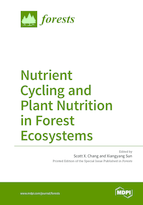Nutrient Cycling and Plant Nutrition in Forest Ecosystems
A special issue of Forests (ISSN 1999-4907).
Deadline for manuscript submissions: closed (31 August 2016) | Viewed by 96933
Special Issue Editors
Interests: forest soil processes; forest fertilization and nutrition; carbon sequestration; greenhouse gas emissions; agroforestry
Special Issues, Collections and Topics in MDPI journals
Interests: forest soils; forest nutrition; soil ecology; revegetation; land reclamation; composting; waste management
Special Issue Information
Dear Colleagues,
Nutrient cycling is essential for maintaining nutrient supply to forest plants and for enhancing forest productivity. Nutrient cycling is also strongly linked to greenhouse gas emissions and thus the global climate change. Nutrient cycling and plant nutrition can be severely affected by anthropogenic and natural disturbance regimes. This special issue will provide an avenue to publish recent progress on research on nutrient cycling and plant nutrition in forest ecosystems and how nutrient cycling and plant nutrition are affected by disturbance regimes such as harvesting, atmospheric deposition and climate change.
Dr. Scott X. Chang
Dr. Xiangyang Sun
Guest Editors
Manuscript Submission Information
Manuscripts should be submitted online at www.mdpi.com by registering and logging in to this website. Once you are registered, click here to go to the submission form. Manuscripts can be submitted until the deadline. All submissions that pass pre-check are peer-reviewed. Accepted papers will be published continuously in the journal (as soon as accepted) and will be listed together on the special issue website. Research articles, review articles as well as short communications are invited. For planned papers, a title and short abstract (about 100 words) can be sent to the Editorial Office for announcement on this website.
Submitted manuscripts should not have been published previously, nor be under consideration for publication elsewhere (except conference proceedings papers). All manuscripts are thoroughly refereed through a single-blind peer-review process. A guide for authors and other relevant information for submission of manuscripts is available on the Instructions for Authors page. Forests is an international peer-reviewed open access monthly journal published by MDPI.
Please visit the Instructions for Authors page before submitting a manuscript. The Article Processing Charge (APC) for publication in this open access journal is 2600 CHF (Swiss Francs). Submitted papers should be well formatted and use good English. Authors may use MDPI's English editing service prior to publication or during author revisions.
Keywords
- Atmospheric Deposition
- Carbon and Nitrogen Cycling
- Disturbance
- Forest Nutrition
- Global Change
- Land Reclamation
- Plant Productivity
- Nutrient Availability







